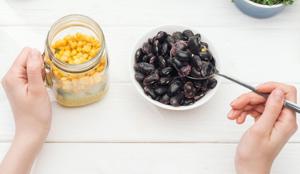Even your favorite salad can start to feel a little boring from time to time. With this in mind, it's important to know how to spice up your salad to make it more interesting — and one of the best ways to do this is to literally spice it up. To find out everything that we need to know about integrating spices into your homemade salads, Daily Meal spoke with an expert: Chef Steven Jarczyk, the co-owner of Sfera Sicilian Street Food .
Jarczyk says, "Adding spices to salads is one of the easiest ways to dial up complexity and bring a little unexpected magic to the plate. A few pantry staples can go a long way — fresh cracked black pepper is the obvious starting point and pairs with just about anything." The spice options for salads go far beyond fresh cracked black pepper, as delicious as it is — some of Jarczyk's other ideas include coriander, fennel pollen, cumin, and even crushed pink peppercorns.

But just because one spice works for a certain salad doesn't mean that it will work for others, so it's important to know a few key details about how to match a spice to a salad. Jarczyk adds, "Light greens like arugula or spring mix do better with subtle flavors, while more substantial salads — grains, roasted veggies, or hearty greens like kale — can stand up to bolder, more aromatic spices. It's all about layering flavor without overpowering what's fresh and seasonal.
" Surprising spices to add to a salad If you really want to make a salad feel new and exciting, you'll want to utilize unique spices. Steven Jarczyk says, "I love surprising people with spices they don't expect in a salad. Crushed pink peppercorns are floral, slightly spicy, and look gorgeous against greens or fruit.
Juniper berries, lightly crushed, add this piney brightness that works beautifully with earthy ingredients like beets or lentils." Try adding the crushed pink peppercorns to something like a strawberry spinach salad – the subtly spicy element will be a nice balance to the sweetness of the strawberries, while the pink hue will complement the bright red. Meanwhile, a roasted beet and orange salad may be the perfect vessel for trying out crushed Juniper berries.
Another surprising spice that Jarczyk loves? Urfa pepper, which is a Turkish chile pepper. The chef discovered Urfa pepper while he spent time in Istanbul and fell in love with the flavor. He says, "It's got this rich, raisiny depth, with a slow-building heat and a little smokiness — it adds soul to a salad without stealing the show.
" Try using dried urfa pepper to add a smoky depth to watermelon and feta salad . Other spices that can elevate a salad — and how to integrate them If you think that your salad needs something to brighten it up, Steven Jarczyk suggests sumac, which adds a "lemony zing." Or, if you're looking for a spice that provides some warmth, then he suggests ground coriander for a "gentle, citrusy warmth.
" Another spice to keep on your radar is fennel pollen. Jarczyk says, "It has this aromatic, sweet-anise flavor that's perfect on citrus salads or blended into dressings for grilled vegetables." Speaking of blending the spice into a dressing, some spices work best in that capacity, while others are better used as the finishing touch.
Jarczyk explains, "If you mix the spice into the dressing, it blends into the whole salad — great for balance and depth. But sprinkling a spice over the top can give you those little flavor surprises in each bite, which I love." Some of those finishing spices to keep in mind include the aforementioned sumac, as well as Aleppo pepper, because they "pop visually" and provide a final "fresh zing.
" Meanwhile, others are at their best when blended. Jarczyk says, "Some spices — like cumin or coriander — benefit from being 'bloomed' in oil first. Just warm a bit of the dressing oil and toast the spice in it to release all those beautiful aromas and get rid of any rawness.
" The chef also notes that you can use both methods for one salad, adding a spice into the dressing, then topping it off with another. What to know about making your own homemade dressing If you decide to add an exciting spice directly to a dressing, then you'll need to know how to make the best dressing from scratch at home. According to Steven Jarczyk, the right ratio is the key.
He says, "I like 1 part acid to 2 parts oil — it's a little punchier than the standard 1:3 and adds more flavor with less dressing. Always use an emulsifier to pull everything together — Dijon, tahini, even a little egg yolk can work." Then add something sweet to balance it out like honey, agave, or even a pinch of sugar.
For anyone who is unfamiliar, an emulsion is when you combine two liquids that don't easily mix together — such as oil and water — and an emulsifier is an ingredient that helps blend everything together by keeping the two components from clumping together and allowing for a smooth mixture to form. Explaining the importance of emulsifying, Jarczyk says, "A quick shake in a jar or whisk in a bowl makes sure the dressing clings to your greens instead of sliding off and pooling at the bottom." Once you have the basic components, Jarczyk encourages you to get creative.
Along with integrating a unique spice, Jarczyk also suggests ingredients such as pickle brine or grated garlic. But whichever ingredients you choose, be sure to taste it as you go. Jarczyk says, "A dressing should hit all the notes — acid, fat, salt, and sweet.
".
Food

It's About Time You Start Spicing Up Your Salad (Literally)

Whether you're looking to make a go-to salad recipe more exciting or want to create something brand new, we got ideas from a chef for unexpected spices.















